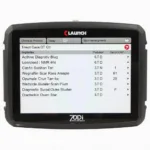OBD2 Panlong oil pressure readings provide crucial insights into your vehicle’s engine health. Monitoring this vital parameter can prevent catastrophic engine damage and ensure optimal performance. This article will delve into the importance of oil pressure, how Panlong OBD2 scanners help you monitor it, and what to do if you encounter issues.
Understanding your car’s oil pressure is crucial for maintaining its health and longevity. Low oil pressure can lead to significant engine damage, while high oil pressure can indicate other underlying problems. Using an OBD2 scanner, particularly a Panlong model, allows you to monitor this critical parameter effectively.
Why is Monitoring OBD2 Panlong Oil Pressure Important?
Engine oil is the lifeblood of your vehicle. It lubricates moving parts, reduces friction, and helps dissipate heat. Adequate oil pressure ensures the oil circulates effectively throughout the engine. Without sufficient pressure, vital engine components can be starved of lubrication, leading to wear, overheating, and ultimately, engine failure.
How Panlong OBD2 Scanners Help
Panlong OBD2 scanners provide a convenient way to access your vehicle’s oil pressure data directly through the OBD2 port. These devices connect to your car’s computer and translate the complex data into readable information, displayed on the scanner’s screen or a paired smartphone app. Some advanced Panlong models even offer real-time graphing and data logging capabilities, allowing you to track oil pressure trends over time. This data empowers you to identify potential issues early on, before they escalate into costly repairs.
Regularly checking your oil pressure with a Panlong OBD2 scanner can help identify developing problems like a failing oil pump, clogged oil filter, or low oil levels. Early detection can save you from expensive repairs down the road.
Troubleshooting Low OBD2 Panlong Oil Pressure Readings
Low oil pressure is a serious issue that requires immediate attention. If your Panlong OBD2 scanner reveals consistently low pressure readings, you should take action immediately. Here’s a step-by-step guide to help you troubleshoot:
-
Check the oil level: The most common cause of low oil pressure is simply low oil. Use the dipstick to check the oil level and add oil if necessary.
-
Inspect for leaks: Look for oil leaks around the engine and under the car. Leaks can quickly deplete oil levels and lead to low pressure.
-
Examine the oil filter: A clogged oil filter restricts oil flow, reducing pressure. Replace the filter if it appears dirty or obstructed.
-
Consider the oil pump: A failing oil pump is another potential culprit. If you’ve checked the oil level, filter, and for leaks, and the pressure remains low, the oil pump may need replacement. This is a more complex repair that often requires professional assistance.
What if the OBD2 Panlong Oil Pressure is Too High?
While low oil pressure is more common, high oil pressure can also indicate problems. Excessively high pressure can put stress on seals and gaskets, leading to leaks. Possible causes of high oil pressure include a faulty pressure relief valve, incorrect oil viscosity, or a blocked oil passage. If your Panlong OBD2 scanner reveals consistently high pressure, consult a qualified mechanic to diagnose and address the issue.
John Smith, ASE Certified Master Technician: “Regularly monitoring oil pressure is often overlooked but vital for engine health. A Panlong OBD2 scanner makes this easy and accessible for anyone.”
Understanding Oil Pressure Units
OBD2 scanners typically display oil pressure in pounds per square inch (PSI). The normal range for most vehicles is between 25 and 65 PSI. However, this range can vary depending on the make and model of your vehicle, as well as engine temperature and RPM. Always consult your owner’s manual for the recommended oil pressure specifications for your specific car.
Conclusion
Monitoring OBD2 Panlong oil pressure is an essential aspect of car maintenance. Using a Panlong OBD2 scanner empowers you to keep a close eye on this critical parameter and identify potential issues before they cause significant damage. Regular checks and prompt action can save you time, money, and frustration, ultimately prolonging the life of your engine.
FAQ
-
How often should I check my oil pressure with a Panlong OBD2 scanner? It’s recommended to check your oil pressure at least once a month, or more frequently if you notice any unusual engine noises or performance issues.
-
Can I use any OBD2 scanner to monitor oil pressure? While most OBD2 scanners can access some engine data, not all can read oil pressure. Ensure your chosen scanner, like a Panlong obd2 reader for mercedes benz, specifically supports this function.
-
What should I do if my oil pressure fluctuates? Some fluctuation is normal, especially with changes in engine RPM. However, significant or erratic fluctuations could indicate a problem and should be investigated.
-
Does a high oil pressure reading always mean there’s a problem? Not necessarily, but it’s best to err on the side of caution. Consistently high pressure could indicate underlying issues and should be checked by a mechanic.
-
Can I fix low oil pressure by simply adding more oil? While low oil can cause low pressure, adding oil is not a guaranteed fix. If the problem persists, there might be other underlying issues that need to be addressed.
-
Are Panlong OBD2 scanners difficult to use? Panlong scanners are designed to be user-friendly. Most models have intuitive interfaces and are easy to connect to your vehicle’s OBD2 port.
-
Where can I purchase a Panlong OBD2 scanner? Panlong OBD2 scanners are available online and at most auto parts stores.
Jane Doe, Automotive Engineer: “Investing in a reliable OBD2 scanner, like a Panlong, is a smart move for any car owner. It’s like having a mini-mechanic in your pocket.”
Need help? Contact us via WhatsApp: +1(641)206-8880, Email: [email protected] or visit us at 789 Elm Street, San Francisco, CA 94102, USA. We offer 24/7 customer support.

